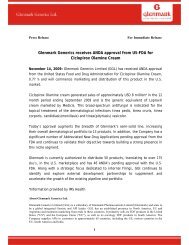Download - Glenmark
Download - Glenmark
Download - Glenmark
Create successful ePaper yourself
Turn your PDF publications into a flip-book with our unique Google optimized e-Paper software.
3.7 PROPERTY, PLANT AND EQUIPMENT<br />
Recognition and measurement<br />
Items of property, plant and equipment are measured at cost less accumulated depreciation and accumulated<br />
impairment losses. Cost includes expenditures that are directly attributable to the acquisition of the asset. The<br />
cost of self-constructed assets includes the cost of materials and other costs directly attributable to bringing the<br />
asset to a working condition for its intended use.<br />
When parts of an item of property, plant and equipment have different useful lives, they are accounted for as<br />
separate items (major components) of property, plant and equipment.<br />
Profits or losses upon disposal of an item of property, plant and equipment are determined by comparing the<br />
proceeds from disposal with the carrying amount of property, plant and equipment and are recognised net within<br />
“other income/expense, net” in income statement.<br />
The cost of replacing part of an item of property, plant and equipment is recognised in the carrying amount of<br />
the item if it is probable that the future economic benefits embodied within the part will flow to the Group and its<br />
cost can be measured reliably. The costs of repairs and maintenance are recognised in income statement as<br />
incurred.<br />
Depreciation<br />
Depreciation is recognised in income statement on a straight-line basis over the estimated useful lives of<br />
property, plant and equipment. Leased assets are depreciated over the shorter of the lease term or their useful<br />
lives, unless it is reasonably certain that the Company will obtain ownership by the end of the lease term. Land<br />
is not depreciated.<br />
The estimated useful lives are as follows:<br />
Factory and other buildings<br />
30 - 55 years<br />
Plant and machinery<br />
8 - 21 years<br />
Furniture, fixtures and office equipment<br />
4 - 21 years<br />
Vehicles<br />
5 - 6 years<br />
Depreciation methods, useful lives and residual values are reviewed at each reporting date.<br />
Advances paid towards the acquisition of property, plant and equipment outstanding at each date of statement<br />
of financial position and the cost of property, plant and equipment not put to use before such date are disclosed<br />
under capital work-in-progress.<br />
3.8 BORROWING COSTS<br />
Borrowing costs primarily comprise interest on the Group’s borrowings. Borrowing costs directly attributable to<br />
the acquisition, construction or production of a qualifying asset are capitalised during the period of time that is<br />
necessary to complete and prepare the asset for its intended use or sale. Other borrowing costs are expensed<br />
in the period in which they are incurred and reported in ‘finance costs’.<br />
Finance costs consist of interest expense on loans and borrowings and impairment losses recognised on<br />
financial assets. Borrowing costs are recognised using the effective interest rate method.<br />
3.9 INTANGIBLE ASSETS<br />
Goodwill<br />
Goodwill arises upon the acquisition of subsidiaries, associates and joint ventures.<br />
Acquisitions prior to 1 April 2010<br />
As part of its transition to IFRS, the Group elected to restate only those business combinations that occurred on<br />
or after 1 April 2010. In respect of acquisitions prior to 1 April 2010, goodwill represents the amount recognised<br />
under Indian GAAP.<br />
Acquisitions on or after 1 April 2010<br />
For acquisitions on or after 1 April 2010, goodwill represents the excess of the cost of the acquisition over the<br />
Group’s interest in the net fair value of the identifiable assets, liabilities and contingent liabilities of the acquiree.<br />
Subsequent measurement<br />
Goodwill is measured at cost less accumulated impairment losses.<br />
Research and development<br />
Expenditures on research activities undertaken with the prospect of gaining new scientific or technical knowledge<br />
and understanding are recognised in income statement when incurred.<br />
Development activities involve a plan or design for the production of new or substantially improved products<br />
and processes. Development expenditures are capitalised only if development costs can be measured reliably,<br />
the product or process is technically and commercially feasible, future economic benefits are probable, and<br />
the Group intends to and has sufficient resources to complete development and to use or sell the asset. The<br />
expenditures capitalised include the cost of materials and other costs directly attributable to preparing the asset<br />
for its intended use. Other development expenditures are recognised in income statement as incurred.<br />
86<br />
GLENMARK PHARMACEUTICALS LIMITED



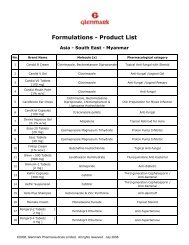


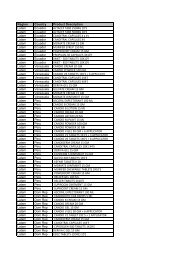
![Formulations [India] â Product List - Glenmark](https://img.yumpu.com/46601329/1/190x245/formulations-india-a-product-list-glenmark.jpg?quality=85)
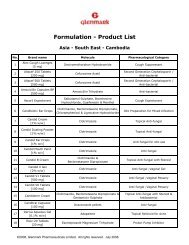
![Formulation [India] â Product List - Glenmark](https://img.yumpu.com/44013338/1/190x245/formulation-india-a-product-list-glenmark.jpg?quality=85)


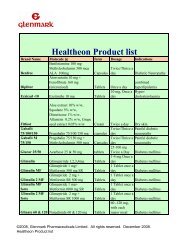
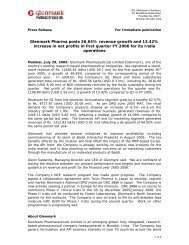
![Formulations [India] â Product List - Glenmark](https://img.yumpu.com/35994839/1/190x245/formulations-india-a-product-list-glenmark.jpg?quality=85)
